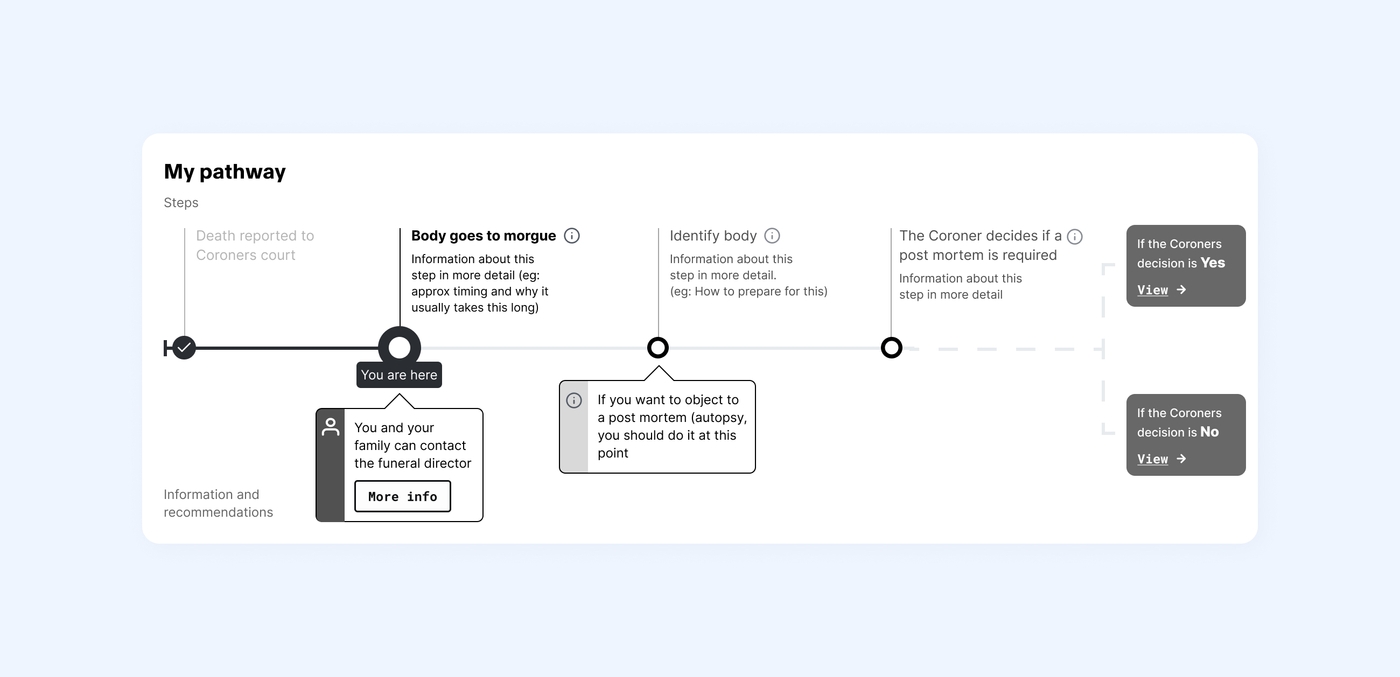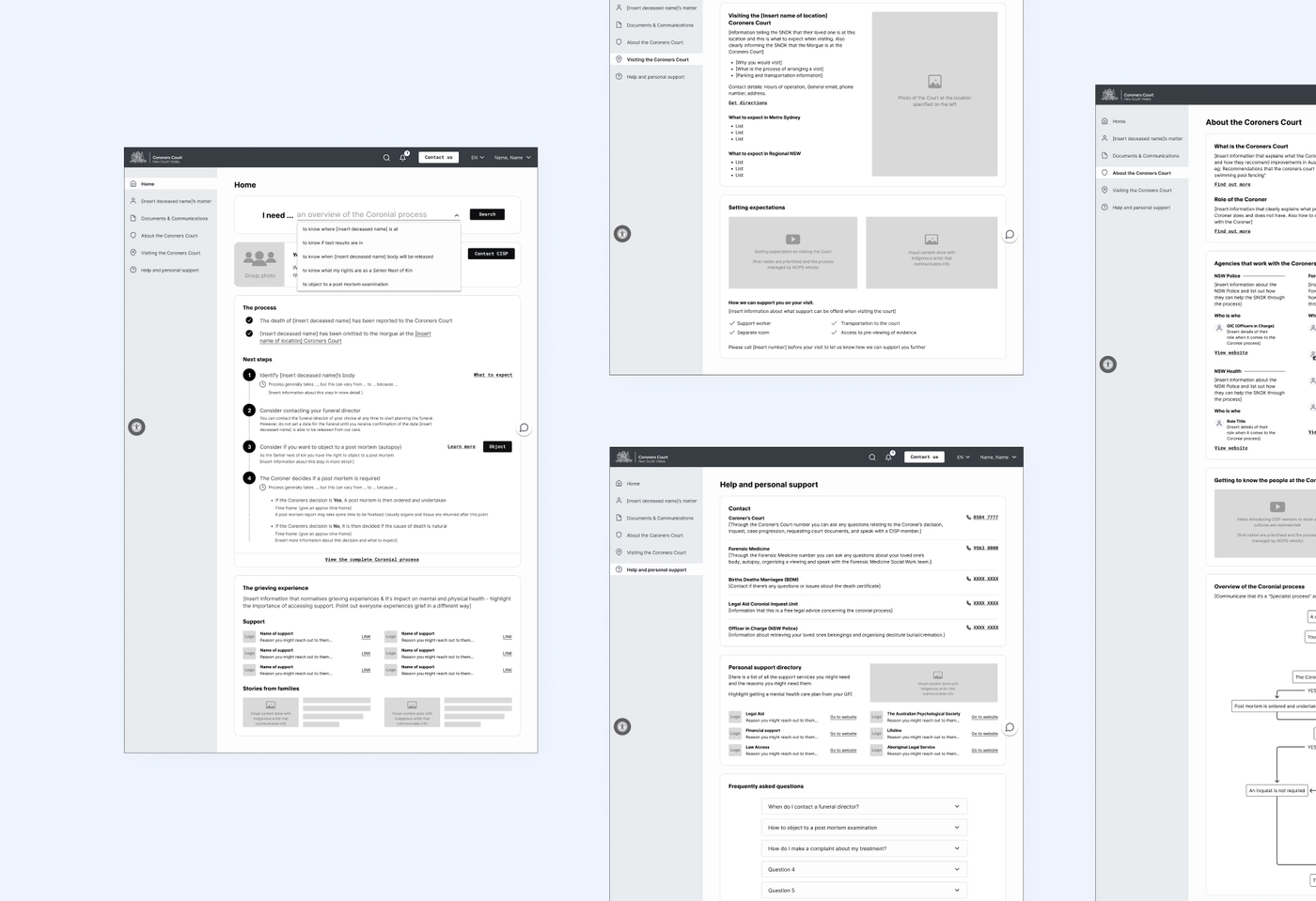The Coroners Court NSW ensures that sudden, unexpected or unexplained deaths, suspected deaths, fires and explosions are properly investigated.
An estimated 6,500 - 7000 families experience significant distress in the early stages of coronial proceedings.
Families experience delays trying to find accurate information regarding the location and progress of their loved one in the coronial process. This tends to occur when they are most vulnerable and most in need of support. Collecting and sharing coronial information between agencies and families is outdated, time-consuming, and relies heavily on manual tasks.
Families and agencies often have to engage with multiple contact points in the coronial system to obtain information, which may not be current or accurate.
Over the last five financial years, the number of reported Coronial deaths has increased by approximately 19% and is expected to continue to grow.
This growth cannot be supported by current resources and systems. An over-reliance on manual processes, outdated communication channels between partner agencies and frequent data entry errors all contribute to;
- Distress for families,
- Significant administrative burdens on staff who would otherwise be prioritising frontline client services, and
- Difficulties in being able to provide timely information to families also places agencies at risk of reputational damage.
Portable was tasked with completing design and discovery research on the journey of someone going through the coronial process when someone close to them dies and designing a digital solution that would meet their information needs.

The Challenge
The current journey for families on the coronial pathway is fragmented, confusing and time-consuming.
The NSW Department of Communities and Justice sought a partner with expertise in human-centred design who could provide insights and recommendations into the experience of families through research, prototyping and testing.
The Department wanted the insights and recommendations from this work to influence the work of the Department’s business analysts and solution architects and provide the foundations for formulating a digital solution that would support families through the coronial pathway.
Our Approach
We took an iterative approach to generate insights for this project, synthesising our findings before moving on to the next step.
Through the project, we developed a series of design outcomes that helped to inform decision-making that would support the development of a grief-informed and human-centred solution.
We developed a set of grief-informed design principles, content and UX design principles, concept recommendations and considerations that could form the basis of any future solution design.
The design principles were intended to ensure that designs would meet the unique needs of families experiencing grief. Recommendations and considerations reflected the way a solution should be designed to meet family needs.
In addition to these, we also developed behavioural personas, journey maps and a digital prototype concept.
We began the engagement by completing a range of discovery activities to understand the current state and identify pain points and opportunities for change.
Understanding the current state
Desktop research
We undertook an extensive literature review. A total of 45 items were identified as containing relevant information and included in the literature scan. This included peer-reviewed research and submissions to the Select Committee on the coronial jurisdiction in New South Wales. Manuals, process documents and external commentary was also reviewed but these items have not been included in the count.
Our research focused on better understanding the inquest process, coronial practice, and the impact of these processes and practices on bereaved families. We also absorbed material on trauma and how to design services that respond appropriately to trauma.
Stakeholder engagement
We also engaged several stakeholders involved in the coronial process (including members of the Coronial Information and Support Program (CISP) team, the Registry, the Police and other third-party support providers) to learn more about the practices of staff and the challenges that people who find themselves involved in the coronial jurisdiction experience.
Observation sessions
We undertook two days of immersive observation at the Forensic Medicine and Coroners Court Complex in Lidcombe.
We used this research method to overcome the drawbacks of other qualitative-research methodologies such as surveys and interviews, which rely on the users’ ability to recall and explain a process they are removed from at that moment. It also opened up an opportunity for the project team to see and hear things they otherwise wouldn’t uncover (habits, side comments, etc.) and appreciate the influence of the environment on processes and people’s behaviour.
These sessions highlighted the impact of paper-based processes on timeliness and the importance of staff taking an empathetic and compassionate approach when supporting people throughout the coronial process.
Defining the problem
Journey maps and personas
For the purposes of this project we created four behavioural personas in the form of engaging personal human stories to highlight the needs, motivations and challenges of the family members we learnt about. This provided the opportunity to build awareness about the dynamic and individual nature of grief and understand the human experiences of users with similar needs.
We also developed journey maps that were associated with the experiences of the four personas, which covered a broad spectrum of interactions.

Designing the future state
Ideation workshop
We then engaged DCJ stakeholders in a series of activities, centred around these prioritised design challenges, to think of possible solutions collaboratively.
The ideas from this workshop were used to create a digital concept, designed to help improve the experience for families.
Clickable prototype
Portable’s designers created a low-fidelity digital concept to test with families and partner agencies.
We then tested the digital concept to explore the desirability of the solution and validate whether it solved the user needs we had previously prioritised.
User testing interviews
The concept was then tested and refined via testing sessions with people with lived experience and key stakeholders, before being shared with DCJ and key stakeholders.
Recommendations workshop and final report
We then synthesised the findings and workshopped recommendations with the DCJ team. These recommendations were placed into 4 buckets:
- Value Proposition: Recommendations for how to make the solution valuable
- Structure: Recommendations about the information architecture of the digital solution
- Content: Recommendations for textual content
- Look and Feel: Recommendations for UI/UX (even though the focus of our testing was not on the look and feel, regardless we collected several insights that we felt would be helpful for the DCJ project team.
Our research has highlighted the significant role that grief plays in families' experiences. Alongside our recommendations for the digital concept, we have strongly recommended service and system-level changes, to better support people through grief and bereavement.

Outcomes
Overview
Through our work, DCJ has been provided with a clear articulation of the experiences of families when they interact with the coronial pathway and have been empowered to be the custodians of change and use these insights to inform a solid business case for future phases of work to digitise the coronial pathway.
The DCJ now has:
- A better understanding of family and partner agencies’ needs, issues and challenges and their role in the coronial pathway, which has been crystallised through detailed personas and journey maps
- Validation of the desirability of a future solution and its suitability
Future prospects
This piece of work sits within the broader tranche of work that is responding to the findings of the Select Committee on the coronial jurisdiction in New South Wales.
We hope this tool will be implemented alongside other improvements to the coronial pathway. This is just one part of a much bigger puzzle.
We hope this work has inspired not only those we worked with but the wider sector involved in supporting people through the coronial pathway in imagining what might be possible.
We also hope our approach has shown the benefit of collaborative and coordinated approaches and has built further capability in service design thinking (and doing) across the Department.
Emily MacLoud, Portable Design Strategist:
“In working so closely with the coronial court staff, we came to appreciate how thoroughly committed and conscientious they are. They are aware of both the emotional and informational needs of those who experience the coronial pathway, yet they are hampered by legacy technology and inefficient processes. While we appreciate that digital solutions are only one piece of the puzzle, we hope that the proposed digital concept alleviates some of the pressure on staff and delivers real value for those who experience the coronial pathway.“
Project Team
- Alice Reeve, Senior Digital Producer
- Emily MacLoud, Design Strategist
- Ash Colcott, Experience Designer
- India Lock, Design Strategist